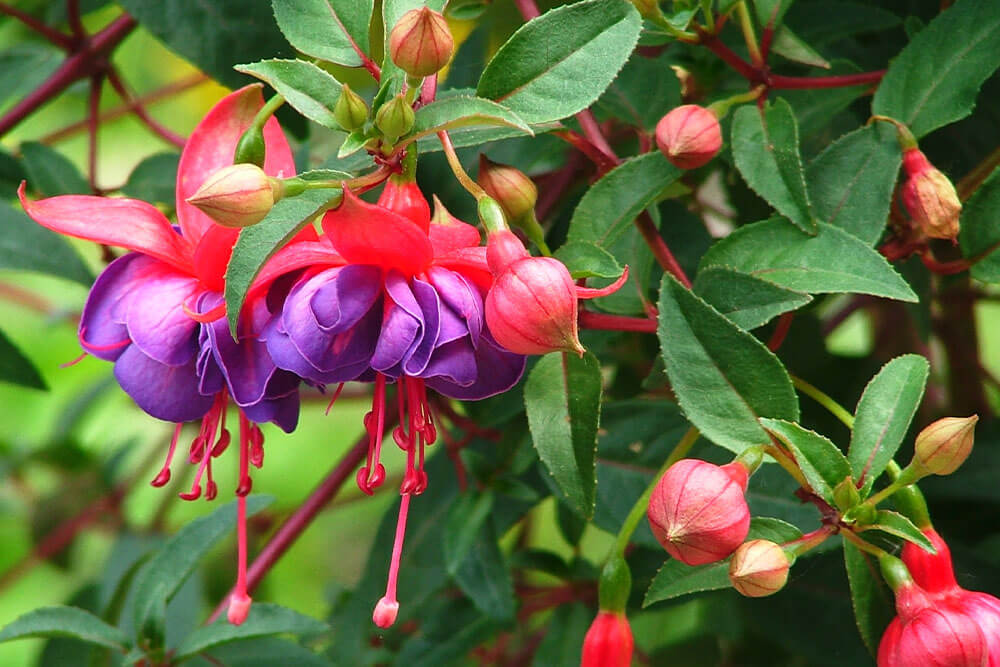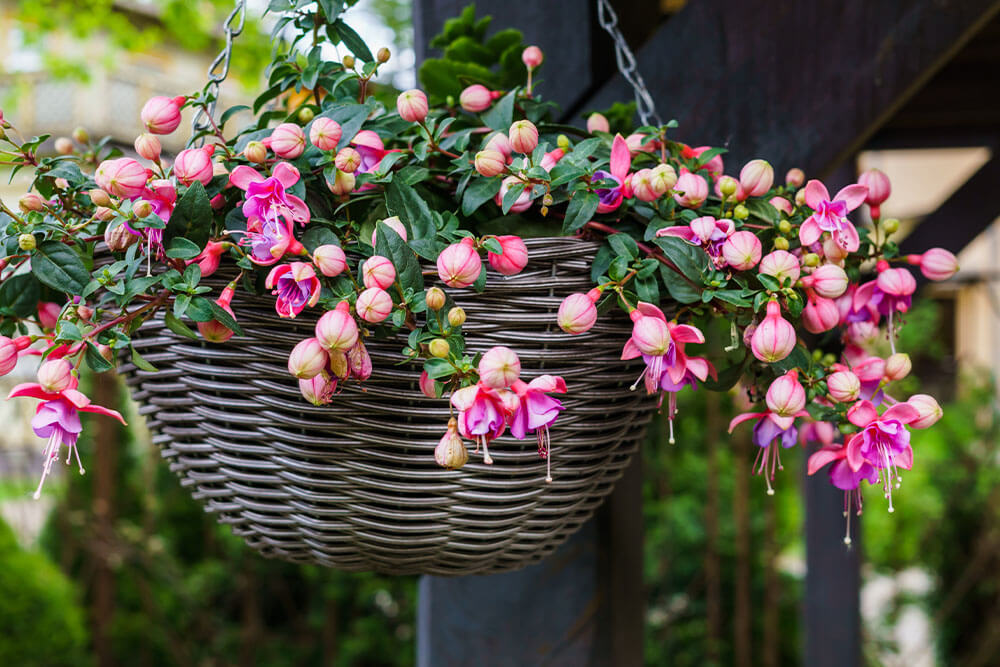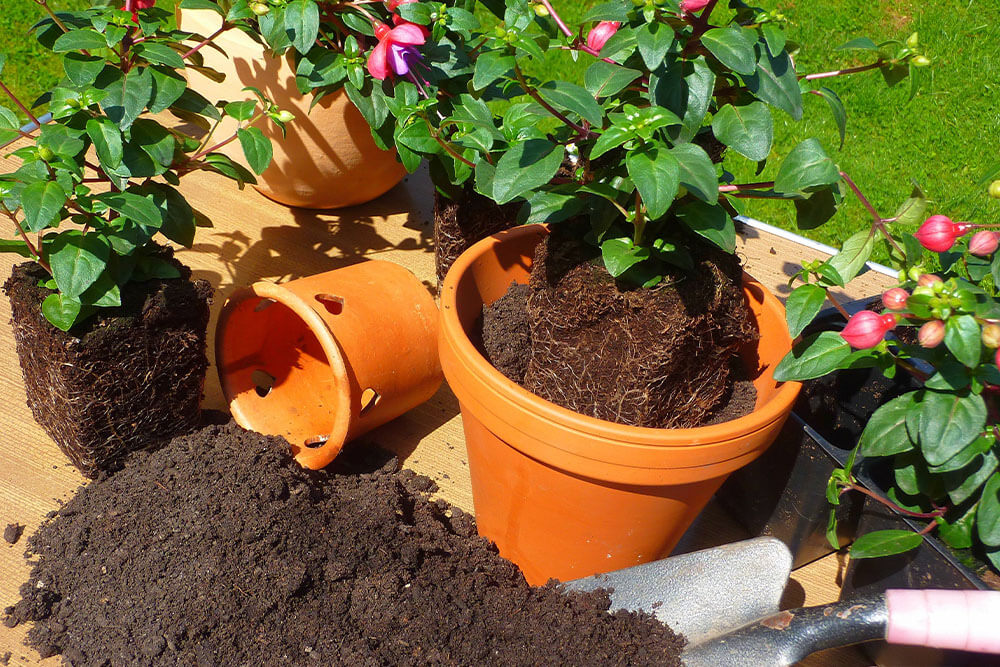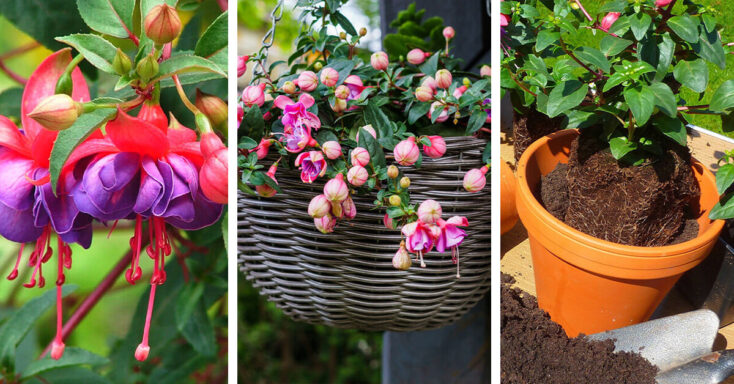Ready to learn everything about fuchsia care? Use this detailed guide to make your fuchsia healthy and thriving!
When someone says fuchsia, you probably think of a specific color. Thus, fuchsia plants have lovely colored flowers. They go by the nicknames Lady’s Slippers and Bubble Plant and are part of the evening primrose family. By the way, most folks misspell it: Fuchsia, not “fushia”.
Key Takeaways
- The fuchsia flower has a tubular or bell shape, and the blooms droop downwards. The flowers only last for a few days.
- Most fuchsia flower varieties comprise red sepals and purple petals. There are some varieties that produce white, orange, yellow, dark red, and purple-blue flowers too.
- Nectar-rich blooms on fuchsias attract pollinators like bees, butterflies, and hummingbirds.
- Fuchsia tolerates various soil types but won’t thrive when it’s overly wet or overly dry.
- These flowers have a long blossoming period from late spring to early fall, providing you with months of beauty.
Flamboyant Fuchsia
Fuchsia flowers originate in Chile, Argentina, and Mexico. Today, they boast over 100 species and rank among the most cultivated ornamental plants. Wherever you place it in your landscape, it makes a bold statement.
If you look at the fuchsias’ stem, it looks so bare and woody. You might not think it would blossom at all. Initially, the flowers look like a bell, at least until sprites emerge. Then fuchsias look like dancing fairies dressed in pink or purple tutus.
You can expect flowers from April to June. Depending on your variety, they appear on a stem, bush, or hanging from the plant. In the fall, the flowers become berries.
Outdoor Fuchsia Care and Keeping

There are a few basics in caring for an outdoor fuchsia plant. Look for a place in your yard where the water remains somewhat even (not too dry or too wet). Either extreme is bad for your fuchsias. If you hang them around outside, you may find they need daily watering, whereas ground-level fuchsia requires water once a week.
Should you fertilize your fuchsia? Yes. This plant benefits from liquid fertilizer applied every two or four weeks throughout the growing season (approximately mid-May to early September). Mulching yearly improves soil quality while helping moderate moisture levels.
Watch your yard throughout the day. You’re looking for a spot with lightly sunny to moderate shade. Don’t go too shady—your plant won’t flower. Too much sun and the leaves may burn.
If you live in USDA zones 10-11, you can grow tender fuchsias. Hardy plants grow in regions 7 to 10. These plants flourish when the temperatures hover around 65 degrees, with a lowering to 55 by night. If it gets over 75F, don’t be surprised if your plant doesn’t flower.
Fascinating Uses for Fuchsia Plants: Native Americans used the fuchsia root to create black pigments they used in coloring wool. Among the Maori, the blue pollen from these blossoms became make-up. In Argentina, you’ll find the fuchsia leaves in treatments for indigestion.
The Needs of Outdoor Fuchsia
Remember that there are 100 known species of fuchsia, each with differing growing habits and requirements. You should hold off on planting fuchsia until the weather stays above 50F nightly. Whether using a plant pot or the ground, dig a hole for fuchsias that’s 2” deeper and twice as wide as the roots. Just as in the garden, your hanging plants need good drainage, too. Check before you buy.
When putting the plant into the ground, backfill with organically enhanced soil. Make sure the stem is a few inches into the soil. Come winter, it protects the fuchsia. Water the plant deeply until it’s well-established in the landscape.
Fuchsia represents different things depending on the setting. For example, in Japan, it’s a symbol of good taste and mannerliness. Across to the west, it’s an emblem of friendliness and secret love. In metaphysical correspondences, fuchsia comes under the moon’s influence, providing adaptability, calm, and a deeper self-awareness.
Finding Fuchsias for your Landscape and Garden
There is no lack of variety among fuchsias, so you should be able to find one that fits your vision for the yard. As you peruse, check to see if the plant is hardy or tender. Hardy fuchsias can withstand winter so you can put them into a permanent home. Meanwhile, as the title implies, the tender fuchsia isn’t a snowbird. It needs safety before the first frost.

- Ballet Girl: The Royal Horticultural Society awarded Ballet Girl with an Award of Garden Merit. It’s no surprise. White-petaled flowers with pink veins and raspberry sepals make quite a view. They grow up to 18 inches tall and 30 inches wide. There are mini versions if you prefer.
- Blacky: The best word for this fuchsia is sumptuous. A 12” tall plant bearing redis external petals. The nearly-black blossom lies within. The sepals are pink with white points. Blossoms from early summer to fall.
- Delta’s Sara: This fuchsia forms an upright bush. The stunning double petals begin with sword-shaped white. The next layer nestled within is purple and pink sepals—an average height of 3 feet.
- Diva Coral and White: An upright branching fuchsia growing 10” x 10”. The blossom is striking, having bright lipstick-pink exterior flowers, followed by white, then sepals again in pink.
- Genii: An award-winning flower, and when you gaze upon it, the reason becomes clear. Medium-sized flowers have an external petal layer of nearly neon pink. Inside you’ll discover curling purple petals and dark blush sepals.
- Glazio’s Fuchsia: A fast-growing plant. Glazio’s small glossy leaves have a bronze tint. Tubular, two-tone flowers (purple and crimson) top red stems. Size: 4-10 feet in both height and width.
- Maiden’s Blush: The oval green leaves act as a setting for slender lilac-pale pink petals. Add white sepals, and it’s lovely. These flowers from early summer to August, reaching a mature height of 3-6 feet and spreading 2-3 feet.
- Miss California: A good choice for outdoor baskets. Thesemi-double flowers go from a dark pink exterior to whisper pink, followed by red staples. Grows to about 30” tall.
- Voodoo: Large red and white double flowers. Voodoo grows 15” tall and 24” wide. The blossom begins with crimson petals followed by violet and finished with a red staple crowned with white.
How was Fuchsia Named?: It’s natural to surmise that Fuchsias got their name from the color. Not so simple! The French botanist, Charles Plumier, gave a nod of honor to another botanist, Leonhard Fuchs. The color fuchsia came along in 1859 as a dye. 1892 was the first time fuchsia was mentioned as a formal color’s name.
Watering Outdoor Fuchsia
Fuschia has a “help me” sign. It will droop quickly when there’s not enough water. The soil shrinks from the side of a container if you’re using one. If the condition continues, old leaves fall off. Several dry spells in a row result in a stressed plant. So as soon as you realize the plant needs moisture, give it a good soak and move it to shade (if practicable) until it improves.
Test your fuchsia soil. Do you know how a sponge feels after you wring it out? That’s ideal. Kind of like the three bears: not too wet, not too dry, but just right! The average fuchsia needs 1 ½ inches of water weekly.
As your grounded plant ages, its root structure improves. Use deep irrigation methods if practicable. Mulch in early summer so the soil retains moisture. Provide water early in the morning. When the afternoon heat arrives, the fuchsia will be prepared.
There is no question that fuchsia likes tropical and subtropical areas. They did, after all, come from places like Mexico and Chili. Nonetheless, Fuchsia isn’t content to stay in one area. Some species of fuchsia (fuchsia dependens) live in elevations upwards of 8,000 to 10,000 feet.
Potting and Repotting Fuchsia
Plant or repot tender Fuchsias in later spring when you know the frost threat is long gone. Hardy ones? Early to late summer.
Soil choice matters. Use peat-free potting mix. Set it up in your chosen container (one with excellent drainage holes) about ⅓ up. Gently remove the fuchsia from its current home. Shake off excess soil and move it into the new pot. Finish covering the plant with soil, giving it a firm tap. Water well.
Propagating
One way of propagating fuchsias is through cuttings. You will need a new green shoot. Cut 6” down, making sure there are leaves still left behind. From here, you have three choices:
- Put them directly into a rooting medium. Developing roots takes 10-20 days.
- Put the end in water and keep the container away from direct sun. Watch the roots grow, but wait to plant them until they’re at least 1” long.
- Place the cutting in a damp paper towel. Keep the towel warm (not hot) and where it receives indirect light. Spritz it daily.
If you wish, you can take your cuttings in late fall. Root them inside where it’s cool (around 50F). Space them out in a growing trench covered with compost. Come spring, you should have shoots you can move outside to the garden.
Very Berry: Fuchsia bears reddish or purple-colored seeds. Within the outer seed, there are numerous “mini” seeds. These are edible as are all parts of the fuchsia. The most popular application for the berries is in jam, baked goods, and puddings. Petals make a delightful addition to a green salad.

Outdoor Fuchsia Pruning and Maintenance
If you potentially want more flowers, pruning can help. The best time is early winter so that it won’t delay blossoms. Come spring, you can lightly prune them just to tidy their appearance. In the cold, it’s not uncommon for fuchsia to have some dieback. Prune away! Getting rid of that makes room for live shoots.
Flower, Bush, or Tree? You’ll come across a wide variety of fuchsia, some of which may surprise you. Fuchsia excorticata grows like a tree. The wood is so hard it cannot be used for firewood. Rather, the dense nature makes the excorticata perfect for carving items to last a long time. Such carvings make lovely, enduring gifts.
Blooming and Resting Periods for Outdoor Fuchsia
Your tender fuchsias should overwinter in an area where there is no chance of frost. Your garage or cellar may work. If you have grounded fuchsias, gently dig them up, transfer them to a temporary pot, and store them indoors. Keep the soil just barely moist during overwintering.
Trim the hardy fuchsias so there are only 4” stems. This is where you can expect new growth come spring. During winter, the base looks brown and woody.
We know fuchsias are edible for humans, but what about cats and dogs? No need to worry! They are wholly safe for your furry friends.
Common Pests and Plant Diseases
There are a variety of critters that might enjoy snacking on your fuchsia. Whiteflies, thrips, mealybugs, spider mites, and scales are very common. How about aphids? Yep, them too. They do a lot of damage to the tips of branches. Their sugary secretion encourages the development of various diseases. You can introduce ladybugs into your garden to fight aphids. Ditto for blackfly.
Two unusual pests are bees and hummingbirds. Sometimes either dives down into the flower bud base, neatly collecting nectar before the bud opens. The approach is aptly called nectar robbing. Other than the plant being slightly disfigured, the effect is minimal.
Speaking about birds and bees, how about caterpillars? They nibble on fuchsia leaves. Pick them off as you see them. If you notice a baby boom where plants go bear, use an organic spray, like Bt (just ask your nursery people). Bt can clear up the problem pretty quickly.
Caspid bugs disfigure fuchsias. They suck sap from the shoot tips. They then bore into the surrounding plant, killing tissue. You may notice small holes in the leaves growing larger. Caspid delays new growth and flower development. Apply insecticidal soap.
When fuchsia experiences ongoing cold or darkness, it may develop gray mold. It’s actually a parasite that seeks out moisture where the leaf connects to the plant stem. You can use a potassium bicarbonate-based fungicide (which also works for various other molds).
Then there’s the dread fuchsia rust. The rust travels quickly on the wind. Once it’s in your plant, it’s hard to get out. Monitor your fuchsia for orange pustules. When you locate them, remove infected leaves. Spray with fungicide, and try to rid yourself of the rust before winter, or it can continue into the next season.
Common Fuchsia Problems
- Failure to bud: Get a soil test. Frequently, this happens due to the soil’s nutrient levels. You need a fertilizer high in phosphorous. Alternatively, your plant may not be getting enough sun.
- Slow new growth: You may have pruned at the wrong time. Pinching them when they’re young encourages blossoming, but pruning old growth can be detrimental. Prune trailing fuchsia in early spring to 6 inches above the top of the soil. As the plant grows, punch branches back to where you see a leaf bud. Keep your plant free of dead, dying, or deformed branches.
Frequently Asked Questions About Outdoor Fuchsia
How do you care for a potted fuchsia?
The only big difference between potted fuchsia and those you put in the ground is water use. A potted plant needs more attention to moisture levels. There is one huge advantage to potted fuchsia-you can move them inside for the winter easily if they’re the tender type.
How do I keep my fuchsia blooming?
Sunshine and well-drained soil sum it up pretty well. Deadhead your plants, fertilize them periodically, and pinch the stems back in spirit.
Will fuchsia survive winter?
If you’re growing tender fuchsia, no. They are not frost and cold-tolerant. Hardy plants can still suffer damage in winter if the weather is harsh. For extra protection, put a layer of burlap, straw, and mulch over your plants for protection.
Where do fuchsias grow best?
While you can place the fuchsia in a shady area, it won’t blossom there. Put your plants in an area where they get direct morning sun, followed by filtered light the rest of the day.
How do you keep fuchsias over winter?
You can move potted and hanging plants indoors, while you have to dig up those in the ground. Basements are good storage areas. Water them discretely when the soil is dry. Bring them back out in spring for a new cycle.
Summary
Fuchsia is a lovely addition to the ornate primrose family. While the genus has just 100 species, there are upward of 5,000 cultivars. In the Victorian Era, these were the “must have” plants. The popularity remains, as reflected by their appearance in gardens, landscapes, and homes everywhere.
The Fuchsia plant has much to offer. It asks for little maintenance and returns your efforts with joyful blossoms. You can use fuchsia in various ways, including as shrubs, hedges, in hanging baskets, and even topiary endeavors.
If you feel creative, fuchsia can be a “garden-to-table” flower. Note that many recipes are reliable, but the flavor of the berries may not remain consistent. Taste test first.
When baking is not in your future, just sit in the garden and revel in fuchsia’s beauty.


